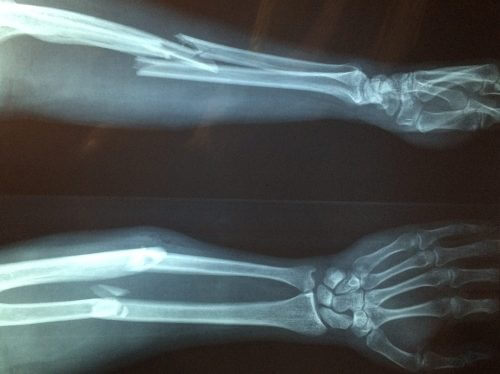A new study indicates a link between air pollution and osteoporosis. What can be done to reduce the danger?

By Racheli Vox, Angle, Science and Environment News Agency
Osteoporosis is a disease that does not excel in its public relations, perhaps because it mainly affects menopausal women, a population that does not gain much of a place in the public consciousness anyway. However, osteoporosis Affects one in three women and one in five men over the age of 50. It causes many to lose their independence and may even eventually lead to death. Article New which was published in the medical journal "The Lancet" and in the writing of which an Israeli researcher was also involved, reveals an unexpected effect on the development of the disease: living in an environment with high air pollution.
"Osteoporosis is a disease that is somewhat neglected, because it is not 'sexy' to talk about it, but it exists in a fairly high percentage of people in the Western world," says Dr. Rachel Golan, an environmental researcher from the School of Public Health at Ben Gurion University. Golan says that every three seconds a bone is broken in the world due to osteoporosis, and this is the most common cause of broken bones in the elderly of both sexes. Among women over 45, osteoporosis is the cause of more hospital stays than diabetes, breast cancer or heart attacks. Bstudy Conducted by the National Center for Disease Control in 2004, the number of women suffering from osteoporosis in Israel was estimated at approximately 194,500. The more significant fractures caused by the disease also magnify You the chance to mortalityFor example, among patients who broke their femur, about 33 percent become nursing and about 24-20 percent Dead בתוך Year from the injury. Fractures in the older population can lead to death reasons variance, including contracting infections during hospitalization and complications in surgeries performed due to the injury.
Naturally, our bone tissue, which is composed of various minerals (such as calcium), is constantly being destroyed and rebuilt throughout our lives. In osteoporosis patients, however, the balance between the two processes is disturbed, and the bone is destroyed faster than it is rebuilt, thus it thins and weakens, and becomes more vulnerable to fractures. The disease usually begins with a sudden fracture of a bone that was not preceded by symptoms. Many patients are not diagnosed and are not properly treated for the disease.
Inflammation and oxidative stress
The new article describes two studies. In the first, the researchers examined the extent of hospital admissions due to fractures resulting from osteoporosis in 2010-2004 in 9.2 million senior citizens in the northeastern United States. The researchers found that people who live in areas with higher concentrations of pollutant particles as small as 2.5 microns, which are one of the most common and dangerous air pollutants, were more hospitalized for fractures resulting from the disease. The risk of hospitalization was highest in low-income communities. According to the results of the study, a small increase in the concentrations of polluting particles in the environment is enough to affect the extent of bone fractures in the elderly.
The second study described in the article included 692 low-income, middle-aged people from the Boston area, who were examined once a year for eight years for parameters related to osteoporosis damage. The researchers found in the subjects who lived in areas with higher levels of pollutant particles up to 2.5 microns in size and of the particulate air pollutant black carbon (the source of which is, among other things, vehicle emissions), greater decreases in bone mineral density, as well as lower levels of parathyroid hormone (PTH), which plays an important role in bones and calcium metabolism in the body, compared to those exposed to lower levels of these pollutants.

It must be remembered that the relationship found in the studies is not necessarily causal. That is, even if living in an area where there is high air pollution is related to osteoporosis damages, the first is not necessarily the sole and exclusive cause of the second. However, the researchers note in the article that particulate air pollution may cause inflammation and oxidative stress - two factors that influence the development of osteoporosis.
Physical activity and pollution reduction
A main way to prevent osteoporosis or reduce its damage is physical activity. "It's something that can prevent the bones from breaking or strengthen them," says Golan. "It is mainly about sports during which force is exerted on the body, such as walking. There are also physical activity classes that are intended for women who are prone to low bone density, at the health funds, for example."
However, it is understood that despite its positive effect on the disease, sports will not protect us from the air pollution in our living environment, which has many negative effects beyond osteoporosis. "Air pollution has been found to be related to negative birth outcomes, mortality, cardiovascular diseases, strokes, respiratory problems and more," says Prof. Itai Kellogg from the Department of Geography and Environmental Development at Ben Gurion University, one of the authors of the article.
"We can help reduce air pollution," says Golan. "More can be done Travel Joint ventures, use public transportation more, ride a bike and walk from place to place if possible." However, according to her, the significant change in the field should come first and foremost from the decision makers. "They need to improve public transportation, test a transition to electric vehicles that will reduce pollution from transportation in the city center, allow infrastructure for cycling and try to reduce pollution from the various factories. Air pollution from transportation is one of the factors Main to infection Air, we are all close to the roads and travel on the roads, so we are all affected", she concludes.
See more on the subject on the science website:
